It was mainly from the 1850s, and especially from the 1870s, that a new kind of teacher in the elementary schools emerged. They were increasingly likely to have had some training, certainly to a greater degree as apprentices, that is pupil and then junior teachers, but also with some time in normal or model schools and eventually teachers colleges. These teachers were also likely to be employees of systems of education or corporate schools, whether denominational (church), secular or those supported or run by colonial governments.
In this process husbands and wives and other family members were less likely to be employed as a unit. In both Catholic and government schools the increasingly typical teacher by the end of the nineteenth century was a single, unmarried woman. In the Catholic parochial schools, these women, sisters (nuns) in teaching orders, received no conventional remuneration. The women in government elementary schools received salaries less than what men with similar education and training received. In this transformation of the teaching labour force, married women were increasingly excluded from employment. It became more difficult for families of teachers to be employed together in schools. The timing of the exclusion of married women and teaching families from employment varies from colony to colony, and after 1901, state to state.
This is not to say that school teaching was no longer a family business in a broader sense. There are many contemporary teachers whose interest in the profession occurs because their parents or other relatives were teachers, but they are employed on their own merits as individuals, not as part of a family. The teaching family lasted longest in the genuine private schools, that is schools owned by individuals and members of their families. Family members of the school owners were often employed as teachers or in other roles, especially where boarding students were taken in. The private schools for girls in the nineteenth century provide multiple examples of this organisation and recruitment of teaching labour, but many private schools for boys in the same period relied on the labour, paid or not, of schoolmasters’ wives, daughters, sons, brothers and sisters.
The teaching family existed as an important source of labour in all colonies, and in private schools from the earliest period of white settlement, and into the first quarter of the post federation (1901) period. William Richardson was the husband of the first documented school teacher in New South Wales, Isabel Rosson. He was often employed with her in schools from the 1790s to 1810.
The ‘teaching family’ underpinned many if not most of the government-assisted Aboriginal schools, and church mission schools through the nineteenth century and beyond. The appointment of married men to such schools assumed a wife would be available, paid or unpaid, to assist with the work.
The Cawthorne family
Georgina Cawthorne with her 16 year old son arrived in the recently founded colony of South Australia in 1841. In the absence of her husband and an income, it seemed sensible to establish a small day school. Georgina taught the girls, and her son William, the boys. Such a division of labour according to sex of teachers and students was usually considered essential in coeducational schools. This was one of the benefits of the teaching family. An elementary school that enrolled boys and girls might employ women to teach girls and males to teach boys.
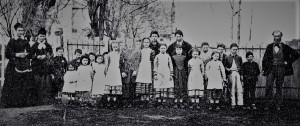
A family run school in Canberra. Jas. Abernathy and daughters who taught together at St John’s School, c1872. (National Library of Australia.)
The survival of a private school was often dependent on a somewhat rare commodity in early colonial Australia: ‘respectability’. The Cawthorne school had a close call early on when it was rumoured that William was interested in kissing the girls. His mother was able to reassure parents and the school survived.
The Protector of Aborigines in the colony offered mother and son the running of the colonial government’s Aboriginal school. They rejected the offer for several reasons, but such an offer confirms the fact that teaching families were desirable units as employees, school operators or owners.
Georgina Cawthorne’s niece, Mary Ann, had arrived in South Australia by late 1845. She taught in her aunt’s school, marrying her cousin William in 1848. The family enterprise diversified. Georgina, Mary Ann and William established their own separate schools. William’s was the ‘Adelaide Grammar School’. Mary Ann’s school operated from her and William’s home. William went on to become a leading educator in the colony from the 1850s, an advocate of the increased professionalisation of teaching, which emphasised individual male careers.
There was a valuable role for wives in the government-subsidised (licensed) schools of South Australia through to 1875. As Chief Inspector William Wyatt explained, where possible in the smaller schools, married men should teach the boys, and their wives, the girls:
I think their [schoolmasters’] moral character should be entirely without stain, and that they should be married men, especially as schools in the country must consist of both sexes and the supervision would in some measure be entrusted to the female as well as the master. (Wyatt, 1851, quoted in Whitehead, 1999, p. 54.)
As historian Kay Whitehead (1999) explained, Inspector Wyatt intended to co-opt the teaching family as an economic and social unit to accommodate the need for sex-segregated schooling. Although he portrayed men as household heads and principal breadwinners, and women as moral guardians and secondary contributors to the family economy, his argument supported an earlier pattern of family-based employment and entrepreneurship in the colony.
The Derrick family
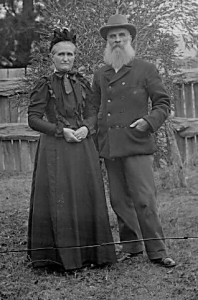
Wives as teachers increasingly unwelcome. Tim Nicholls, head teacher at South Gundagai Public School with wife, c1894. (Photo: Charles Gabriel, National Library of Australia.)
As the movement of teaching labour towards individual employees recruited by centralised education departments sped up from the 1870s, the arrangements of teaching families working in government-subsidised schools were often disrupted. In Melbourne, Joseph and Brunette Derrick (husband and wife) lost their school in 1874. Joseph had been head teacher since 1857, and Brunette joined him as an assistant teacher following their marriage in 1858. The leading teachers of such schools lost their power to appoint subordinate teachers, often members of their own families, as the schools were absorbed into the public system. It was not only the loss of the combined or family-based teaching income and the comfort of working together in the same school that was a problem. As Joseph protested in anticipation of the changes:
I and my wife are now, and have been getting a very comfortable income, which I pray may be continued … My wife would feel very acutely to be an assistant to any person but me. (Joseph Derrick, 1873, quoted in Theobald, 1990, p. 29.)
As historian, Marjorie Theobald (1990) argued, “publicly funded elementary schools were frequently regarded as family fiefdoms, both by the incumbent family and by their clientele” (p. 29). Wives and older children could no longer be so easily employed. Men did not necessarily wish to see their wives delivered into the hands of other headmasters in schools not run by themselves.
Two families and the Unley Park School
Having lost her husband to drunkenness and “temporary insanity” Catherine Thornber opened a school, mainly for girls in southern Adelaide in 1855. Her eldest daughters, Catherine and Rachel, and later the younger Ellen, worked in the school. The curriculum necessarily included accomplishments as well as English (modern) subjects. Rachel Thornber concentrated on running the household, looking after the needs of the boarding students. It was a school run by the Thornber family into the 1880s, Catherine and her three unmarried daughters. Teachers outside the family, some men but mainly women were also employed.
In 1907 the school was transferred to Caroline and Annie Jacob who had learned the art of school teaching and management in their mother’s private school in Mount Gambier. Another sister, Nellie ran the household, but the school lasted only three years. By this time Methodist Ladies College was in the ascendant, the coeducational Adelaide High School had opened, and the Victorian era, family-based private schools, were finding it difficult to compete.
From school to school, the teacher as public servant
By the 1880s the kinds of employment that engaged whole families were coming to an end. The typical teacher from that time was a salaried employee of a government department of education or public instruction, and increasingly an unmarried woman.
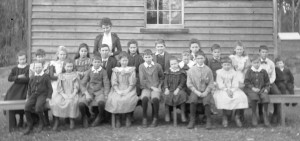
Independent of fathers and husbands. Elizabeth Smyth with her students at Wagonga provisional school, NSW, c1892. (National Library of Australia.)
From a rural farming family in New South Wales Mary Gilmore determined on teaching in public schools as a career. From age 12 in 1877 she acted as an “unofficial” pupil teacher in several small rural schools, but formal employment followed at age 16 when she passed an examination enabling her to become a probationary pupil teacher at the Superior Public School in Wagga Wagga.
Examinations, meeting promotion requirements, accessing transfers to schools of differing status, passing official inspections and becoming classified as a teacher at different levels all marked out and regulated the new kind of individual teaching career. The importance of family effort in schools was being rendered obsolete. The public education systems insisted on bureaucratic approaches. Central regulations were published, ordering this new kind of teaching career.
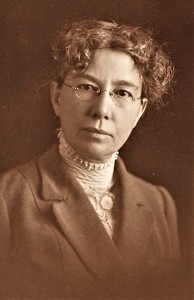
Mary Gilmore, teacher and poet, 1916. Photo: May Moore. State Library of New South Wales
In 1884 Mary Gilmore failed a teaching examination, but in 1886 was employed as a teacher in a rural provisional school, and then in a public school. (Provisional schools had too few students to be designated “public” schools, and the teachers who worked in them usually had inferior qualifications.) Mary then passed her IIIA teachers examination, being appointed in 1887 to a town close to the South Australian border near Broken Hill. She was a “temporary assistant” there until a transfer to Sydney, the Neutral Bay Public School in 1890, and a year later to Stanmore Public. Socialist politics called (Gilmore went to the New Australia settlement in South America), and she married, marking an end to her teaching career.
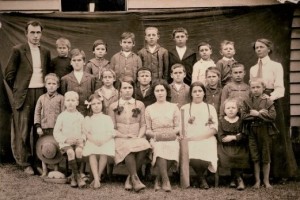
A late survivor of family enterprise in schools. Annie Murdoch (right) was the wife of Bruce Murdoch, head teacher. She taught sewing to the girls. Boambee Public School, 1911. (Coffs Harbour Regional Museum.)
This kind of career was modern. Though subject to the authority of male headmasters and inspectors, Mary Gilmore was a teacher who moved from school to school across New South Wales–without husband, father (or children) to govern or affect the circumstances of her teaching.
A new kind of teacher
The age of the teaching family was not quite over in the late nineteenth and early twentieth century. In one and two teacher rural schools, the wives of teachers could be employed to teach the girls sewing for example. There is evidence to suggest that they did far more than teach sewing. In many cases, if enrolments were too few, wives might teach sewing and more without payment. Parents were often suspicious of schools where there was but one male teacher. A female presence was very desirable.
The possibility of such married women being employed as full teaching assistants with their husbands eventually disappeared. Men and women were employed as individuals, usually with substantial penalties involved if women married. Employment was often lost altogether (the “marriage bar”), and the women who did not marry were promoted less, paid less, and when superannuation began to be offered, enjoyed inferior access. In Catholic schools lay teachers, male and female lost their jobs and schools as religious orders took over and founded schools in the nineteenth century. The severity of the disadvantages for married women varied across the different states of Australia, sometimes lasting until the 1960s and 1970s. Married women might be treated better in some nongovernment schools. (In Catholic schools lay teachers were required once more from the 1960s as a shortage of religious, nuns and brothers, set in.) In government schools as a consequence of the baby boom of the 1950s and 1960s, married women were employed once more, though often on inferior employment contracts compared with unmarried women and men regardless of marital status. By the 1980s marital status was much less likely to be an issue for employment as a teacher, though discriminations on that basis could occur. Nevertheless, modern teaching careers were for individual employees, not families.
NOTE: The author thanks Professor Kay Whitehead for assistance in the writing of this entry.
